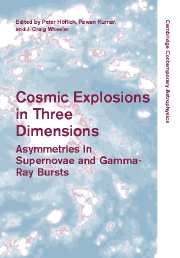Book contents
- Frontmatter
- Contents
- Part I Introduction
- Part II Supernovae: Observations Today
- Part III Theory of Thermonuclear Supernovae
- Part IV Theory of Core Collapse Supernovae
- Part V Magnetars, N-Stars, Pulsars
- 30 Supernova remnant and pulsar wind nebula interactions
- 31 X-ray signatures of supernovae
- 32 Neutron star kicks and supernova asymmetry
- 33 Triggers of magnetar outbursts
- 34 Turbulent MHD jet collimation and thermal driving
- 35 The interplay between nuclear electron capture and fluid dynamics in core collapse supernovae
- Part VI Gamma-ray Bursts
- Part VII Conference Summary
- References
31 - X-ray signatures of supernovae
Published online by Cambridge University Press: 11 August 2009
- Frontmatter
- Contents
- Part I Introduction
- Part II Supernovae: Observations Today
- Part III Theory of Thermonuclear Supernovae
- Part IV Theory of Core Collapse Supernovae
- Part V Magnetars, N-Stars, Pulsars
- 30 Supernova remnant and pulsar wind nebula interactions
- 31 X-ray signatures of supernovae
- 32 Neutron star kicks and supernova asymmetry
- 33 Triggers of magnetar outbursts
- 34 Turbulent MHD jet collimation and thermal driving
- 35 The interplay between nuclear electron capture and fluid dynamics in core collapse supernovae
- Part VI Gamma-ray Bursts
- Part VII Conference Summary
- References
Summary
Abstract
Combining sub-arcsec imaging with moderate spectral resolution and high throughput, the Chandra X-ray Observatory enables spectacular views of Galactic supernova remnants as well as X-ray studies of compact remnants, young extragalactic supernovae, and gamma-ray burst afterglows. In this contribution, I briefly review the capabilities of Chandra and then describe some recent observations of supernovae and supernova remnants made with Chandra.
The Chandra X-ray observatory — an overview
Chandra (see, e.g., Weisskopf et al. 2002) was launched from space shuttle Columbia 23 July 1999 and is now late into the fourth year of its ten year mission. The heart of the facility is the High-Resolution Mirror Assembly consisting of 4 nested mirror pairs with a 120 cm outer shell diameter. The mirrors provide about 800 cm2 of collecting area at 1 keV and about 400 cm2 at 5 keV. Most importantly, the mirror design results in less than 0.″5 on-axis spatial resolution; an order-of-magnitude higher resolution than any other X-ray facility yet flown. This corresponds to a resolution of ∼100 AU at the distance of the Crab Nebula; making Chandra ideal for probing the fine structure of supernova remnants on spatial scales comparable to that achievable by some of the best ground-based optical telescopes. Equally important, high spatial resolution improves the sensitivity of X-ray measurements by concentrating source photons into a small area thereby minimizing the contribution from the underlying background. There are two types of focal plane instrument onboard Chandra.
- Type
- Chapter
- Information
- Cosmic Explosions in Three DimensionsAsymmetries in Supernovae and Gamma-Ray Bursts, pp. 270 - 275Publisher: Cambridge University PressPrint publication year: 2004



